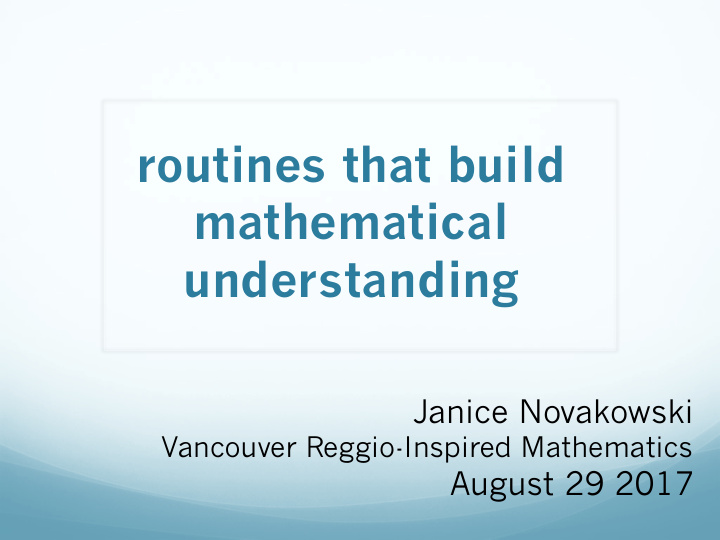



routines that build mathematical understanding Janice Novakowski Vancouver Reggio-Inspired Mathematics August 29 2017
why mathematical routines? regular practice that responsive to students has multiple entry focus on a pedagogy of points, open-ended noticing and listening and personalized many can be used helps to build a across mathematical mathematical curricular content community in the strands classroom focus on curricular collaborative competencies, encourages particularly thinking, mathematical reasoning and discourse communication
Quick Images Dot Cards Ten Frames Rekenrek Shape Compositions (2D and 3D)
Counting sequence of number names – stability one-to-one correspondence cardinality conservation – stability in quantity relative size of quantities connecting quantity, number name and symbol
counting forwards and backwards from various starting points base ten structure of number system skipcounting, multiples apply counting concepts to fractions, decimal numbers
Choral Counting University of Washington: tedd.org
Counting Collections #countall
Ways to Extend Counting Collections different ways of recording math storytelling problem posing and solving make math to math connections
What are Number Talks? 5-15 minute classroom routine focused on thinking, learning and communication developing mental math strategies and computational fluency that builds from understanding number relationships teacher as facilitator classroom discussion and justification of strategies intentionally chosen number strings, problem sequences
Starting at the beginning… Creating a safe classroom community Value different ways of doing things, risk-taking, okay to disagree, listening to each other Start where the students are What strategies do they know? How do students communicate their thinking?
Mental Math Strategies Kindergarten: one-to-one correspondence, decomposing numbers, five and ten-ness Grade 1: counting on and back, making 10, doubles, using addition to subtract Grade 2: making or bridging ten, related doubles, adding on to find the difference, decomposing, compensating Grade 3: decomposing, compensating, commutative property for +
Mental Math Strategies Grade 4: distributive and commutative principles, doubling or halving, repeated doubling (multiplication) Grade 5: annexing, halving and doubling, distributive property (multiplication) Grades 6&7: practice and application of the strategies
18 + 7, 48+7, 48+37 a number talk sequence Intentionally selected numbers Number talk sequence or string is scaffolded, builds on itself Focuses on one targeted mental math strategy but may involve others Students share thinking orally, teacher models recording of strategy use
93-50, 93-49, 123-49 A Number Talk sequence/string Why were these numbers chosen? What mental math strategies might students use to figure these questions out? What models might help students think about these questions?
Planning for Number Talks Think about what strategies your students have demonstrated competency in and what strategies need further development Choose strings of problems intentionally to practice and develop strategy use Consider what structures could support student learning - targeted small group math instruction (guided math), visual support, practice materials
Extending Number Talks Use a number talk as a community time to respond to what you are are noticing needs some development – a specific strategy, number range, concept, discourse, curricular competency The main idea from the number talk can frame what students do as they engage with materials, language or ideas through provocations or investigations Small group or guided math sessions can be connected to the number talk
Number Talk Images
WODB: Which One Doesn’t Belong? http://wodb.ca Can be used across mathematical curricular topics Often begin with What do you notice? How are they alike/same? How are they different?
What teachers are saying… “Every child has an entry point. There is often one choice that is different in colour or is visually different.” “The mathematics they uncover always surprises me.” “The students really love working together as a pair to share their thinking.” “It is such a great routine to focus on communication and using specific mathematical vocabulary.”
Just published… Order through Pembroke Publishing (Canada) or Talking About Math with Your Kids (https://talkingmathwithkids.squarespace.com)
WODB Posters Right now, only available through Stenhouse Publishers in the US (need to ship within US)
Clothesline An interactive numberline Focus on number sense and relationships Ordering whole numbers through fractions through expressions including exponents and variables
Extending the Clothesline Using multiple representations Using double or triple clothesline
thank you! jnovakowski@sd38.bc.ca on Twitter @jnovakowski38 Reggio-Inspired Mathematics blog http://janicenovkam.typepad.com/reggioinspired_mathematic/ district blog: http://blogs.sd38.bc.ca/sd38mathandscience/
Recommend
More recommend